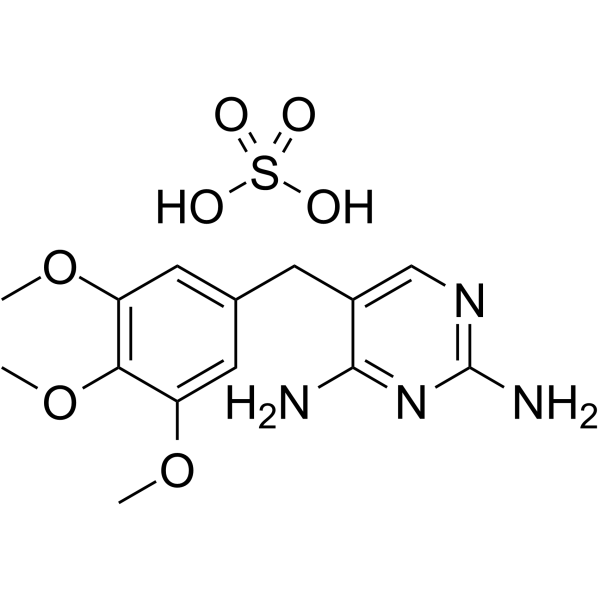| Description |
Trimethoprim sulfate is a bacteriostatic antibiotic and an orally active dihydrofolate reductase inhibitor. Trimethoprim sulfate is active against a wide range of Gram-positive and Gram-negative aerobic bacteria. Trimethoprim sulfate has the potential for the research of urinary tract infections, Shigellosis and Pneumocystis pneumonia. Trimethoprim sulfate can inhibit infection of Influenza A virus in chick embryo when combinated with zinc[1][2][3][4].
|
| Related Catalog |
|
| Target |
Dihydrofolate reductase, Bacteria[1] Influenza A virus[4]
|
| In Vitro |
Trimethoprim interrupts folate metabolism by inhibition of the activity of dihydrofolase reductase (DHFR), which reduces dihydrofolate to tetrahydrofolate (THF)[1]. Trimethoprim (3 μg/mL; 1 h) induces protein aggregation and main heat shock proteins (Hsps) in E. coli cells, which indicates that Trimethoprim sulfate presence leads to protein misfolding[1]. Trimethoprim (1.5-3 μg/mL; 1 h) causes induction of DnaK, DnaJ, GroEL, ClpB, and IbpA/B Hsps in E. coli cells exposed to folate and heat stress[1].
|
| In Vivo |
Trimethoprim (10 mg/kg; i.v.; once every 12 h; 3 d) shows antibacterial activity against H. influenzae, S. pneumoniae, E. coli and N. meningitidis in infected mice[2]. Trimethoprim can be connected with the thiomaltose (TM-TMP) and shows stability with a half-life of about 1 hour in complete serum, and has an MIC value around 1 μM against E. coli[2]. Trimethoprim (10 mg/mL; 0.5 mL; inject with Trimethoprim-Zn combined suspension) decreases the virus titer and increases the survival rate of chicken embryo[4]. Animal Model: Female C3H/HeOuJ mice (transurethrally infected with a 50 μL suspension containing 1-2×107 CFU of E. coli under 3% isoflurane)[2] Dosage: 10 mg/kg Administration: i.v.; once every 12 h; for 3 d Result: Showed antibacterial activity against H. influenzae, S. pneumoniae, E. coli and N. meningitidis with CD50s of 150 mg/kg, 335 mg/kg, 27.5 mg/kg and 8.4 mg/kg, respectively in infected mice. Animal Model: Fertilized eggs (injected H3N2 virus into amniotic and allantoic space at day 8)[4] Dosage: 10 mg/mL; 0.5 mL Administration: The Trimethoprim-Zn combined suspension was injected into the air sac; single dosage Result: Decreased the virus titer and increased the survival rate of chicken embryo. The survival rate peaked at ratio about 0.18 (Zn/Trimethoprim).
|
| References |
[1]. Laskowska, E., et al., Trimethoprim sulfate induces heat shock proteins and protein aggregation in E. coli cells. Curr Microbiol, 2003. 47(4): p. 286-9. [2]. Xiaojian Wang, et al. A Trimethoprim sulfate Conjugate of Thiomaltose Has Enhanced Antibacterial Efficacy In Vivo. Bioconjug Chem. 2018 May 16;29(5):1729-1735. [3]. Brogden, R.N., et al., Trimethoprim sulfate: a review of its antibacterial activity, pharmacokinetics and therapeutic use in urinary tract infections. Drugs, 1982. 23(6): p. 405-30. [4]. El Habbal MH. Combination therapy of zinc and trimethoprim inhibits infection of influenza A virus in chick embryo. Virol J. 2021 Jun 3;18(1):113.
|
